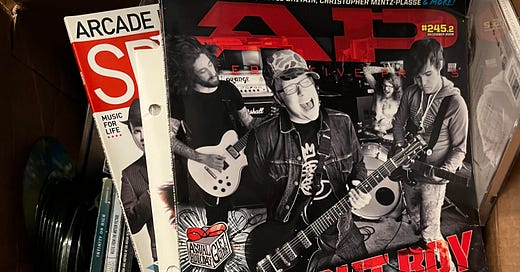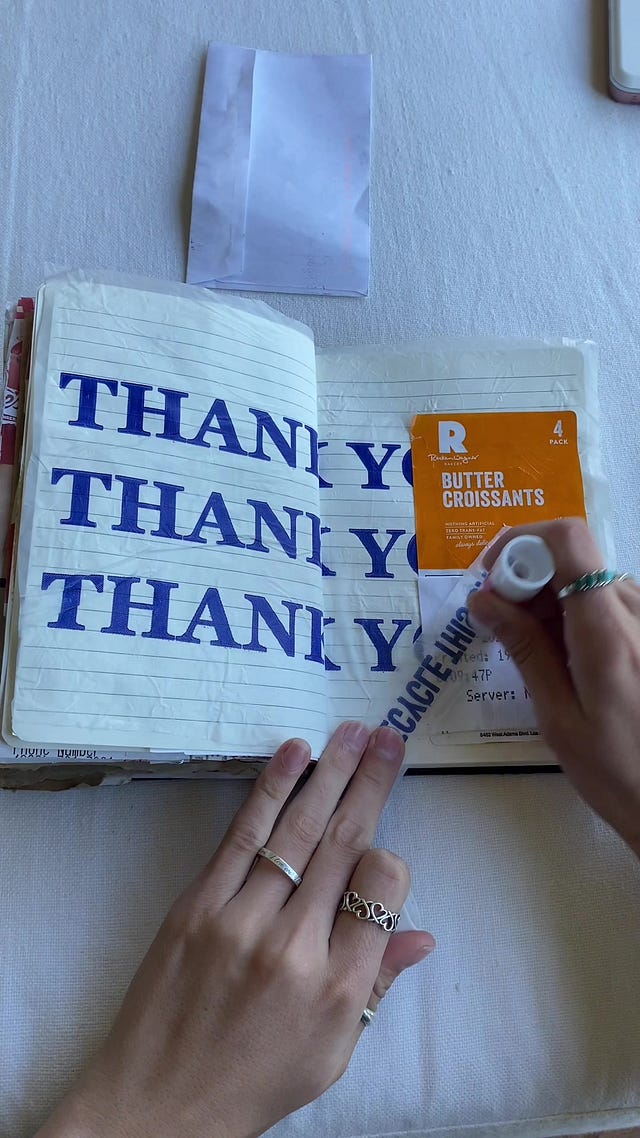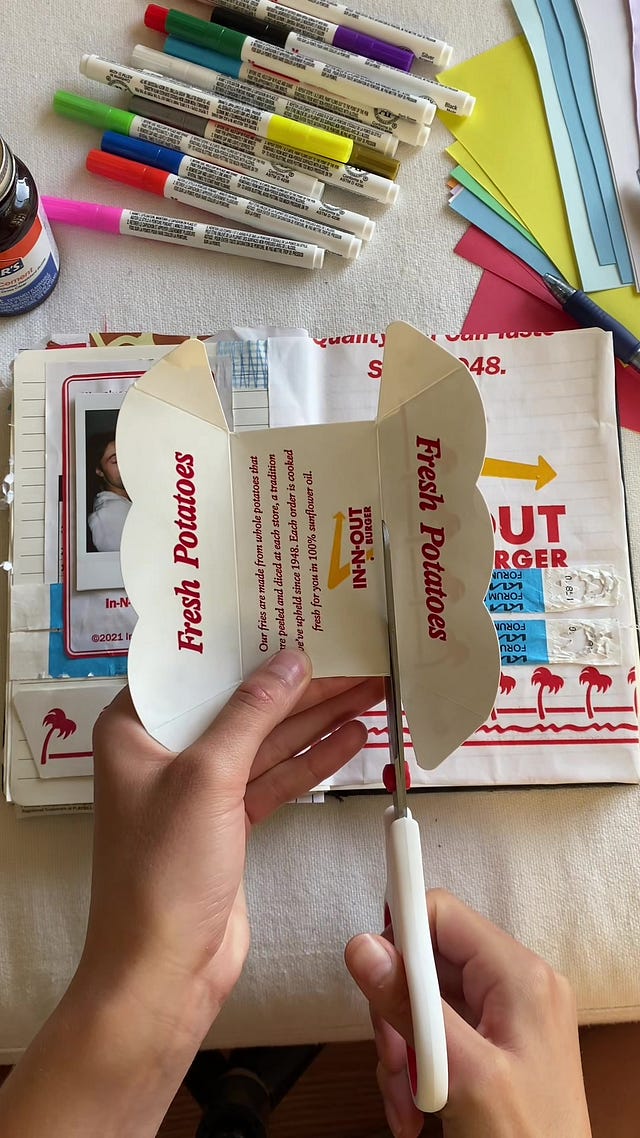If you read my newsletter before or followed my writing for a period of time, you know I’m nostalgic as hell. I love reminiscing; old photographs, letters, movies, you name it - I’m probably indulging. Quite frankly, I thought it was just a symptom of growing older, combined with the passage of time. It wasn’t until recently that I unearthed a box (actually a few) after genuinely wondering where my high school yearbook was, and I landed on the motherload. In reality, I’ve actually been like this since I was a kid. The box had dozens of old magazines from my favorite bands, letters that I’d written, lots and lots of journals, photos, and scrapbooks. Under all of that was also old Barbies that look like they’d seen war, movie tickets, dozens of burned CDs, and signed shirts from my 8th grade classmates. I’m sure there’s way more of it, as I’ve had to pair down over the years, but my collection expanded to dozens of Seventeen Magazines, and Cosmo, along with American Girl in my earlier years. I’m not quite sure what compelled me to keep them, maybe I’m just a big sentimental baby at heart and I’m sure that has something to do with my love of photography too, overly obsessed with capturing memories.
My personal archive has grown digitally as well, with hundreds of pictures on Facebook, Instagram, and on various hard drives from different chapters in my life. Still, nothing might be as satisfying as pulling out that big book with pieces of paper flying out, trying to figure out how to decipher my 12 year old self’s handwriting. In my recent newsletter, I talked about nostalgia for physical music media and reviving my old iPod. But, these boxes of memories are a different kind of capsule. The way the songs exist as a snapshot of a time in my life, these momentos do too, but it plays on my heartstrings in a different way. I can feel myself connecting to my inner child, seeing her differently for the first time in a while, and not in a sad way either. She’s funny, witty, and a little weird, and she was, and is, always writing.
In an article for Elle, writer Ekta Sinha writes about scrapbooking connecting together generations of people that have always had an affinity for collecting bits and pieces of their lives, as both a form of memory keeping, but a way to store ephemera:
It’s heartwarming to watch this trend taking over the art space where artificial intelligence is altering the nature of art. Even in digital spaces like Canva and Photoshop, there is a notable resurgence of the traditional craft of scrapbook effects, especially with the newer generation. Scrapbooking continues to have a timeless appeal and a distinct place in the creative world, even in the face of the explosion of scary AI-powered art.
More recently, scrapbook has been referred to as junk journaling, which I can verify via my TikTok feed, that it is, in fact, gaining popularity again. You can imagine my excitement when during a late night scrolling session that I saw people from literally all walks of life doing things with scrapbooking that I didn’t know were possible. One of the main draws is that there’s quite literally no barrier to entry. I’d always had the idea that I needed a special book for scrapbooking, with special paper and tape - which plenty of people do. But I saw all types of scrapbooks being used, and combining pages from old books, newspapers, and flyers to make backgrounds. It’s not just incredibly clever, it’s one of the more eco-conscious hobbies I’ve seen. Yes, you’re collecting stuff but you’ve repurposed items that would have been in the garbage otherwise. Simply put — junk journaling gives stuff a new life.
(I honestly would have never thought to recycle a plastic bag to use as a background against paper to create a spread.)
Although there’s no rules to junk journaling, everyone has their own distinct aesthetic and ways they like to do things. It excites me that being excessive and gaudy is encouraged. Add more things! Stickers, gems, the world is your oyster! Another one of the draws to scrapbooking and junk journaling is that it plays on our childlike affinity to be over the top. We get to indulge ourselves in ways that we’re not normally encouraged to do. Plus, these books are for us and us only. They might be shown off to a friend or family member out of excitement, but otherwise who cares what we do with them. (I mean that in the most liberating way possible)
(This is so creative but I can’t help but think that my journal would smell like a burger and fries in perpetuity.)
It’s been said that junk journaling helps reduce stress and better mental health and, well, duh, I could have figured that out. I’m fairly sure that any creative practice that gets us into a meditative state: making music, drawing, singing, writing, etc. would be good for our well being. Also, in those moments where you feel like writing won’t quite capture the essence of the moment, a stack of pictures and assorted items will definitely do the trick. Back in 2014, Smithsonian Magazine did an entire piece on scrapbooking, calling it the blogging of the 19th century and a “modern habit of cut and paste.”
Scrapbookers were also aesthetes. Enchanted by the sumptuous graphic design on display in this new world of daily publications, they clipped and saved color prints and advertisements. The mid-to-late 19th century “was the first time the average person saw something in color,” says Susan Tucker, an archivist and curator at Tulane University and co-editor of The Scrapbook in American Life. “These seemed too precious to throw away.”
Collaging as a cross-cultural art form excites me because it’s a reminder that we’re all very much alive and experiencing this life together. Our walks may look different but I still feel the pang of nostalgia, seeing someone's collection of items knowing that this makes up what is important to them. Our scrapbooks and collages are a safe space for us, with nobody telling us what to do, it allows us to express ourselves free of judgement.
Self-proclaimed “sentimental crafty girl” Martina Calvi runs a small business where she sells craft materials. Martina has made a name for herself on social media, posting her junk journals and bonding with fellow sentimental girls alike. In a profile for Sauce, she says that she finds the everyday moments to be beautiful, and rather, an opportunity for her to be more creative. It reads:
With projects like these, Martina is championing the new art of ‘girl mess’ – a TikTok-born subculture that pushes back against the sad minimalist world of blank spaces and few belongings. ‘Girl mess’ sees messy piles, trinkets and tchotchkes as evidence of authenticity and sentimentality rather than signs of laziness, hoarding or ‘women’s stuff.’ In her own words, ‘girl-mess’ “embraces the messiness, intricacies and fragments of everyday life and girlhood.” By capturing things as they are, she’s fascinated by the power of ‘girl-mess’ not to “leave out what’s interesting and real to a person.” This has led to Martina’s one-of-a-kind art style that’s filled with personal tokens, real life and fun-for-fun’s sake – and wants you to create, tinker and play with no end insight as well.
Martina is also the author of The Art of Memory Collecting, a book featuring different collaging and scrapbooking projects, along with different techniques and inspiration. Her way of creating is definitely aestheticized and I frequently see people trying to emulate that in their own journals. And I’ll be honest, it’s fun. I like that people are collectively getting excited about something as small as a napkin from a bar, just because it represents something special to them. Seeing people make something out of nothing has always both baffled and inspired me, because suddenly, the wheels are turning and I’m pulling the dustiest boxes out of the closet, trying to find a journal from 2003.








I'm also wildly sentimental, I love that this is something people are doing more and more. Thank you for the pictures you included, it's so cool to see what ideas other people come up with!